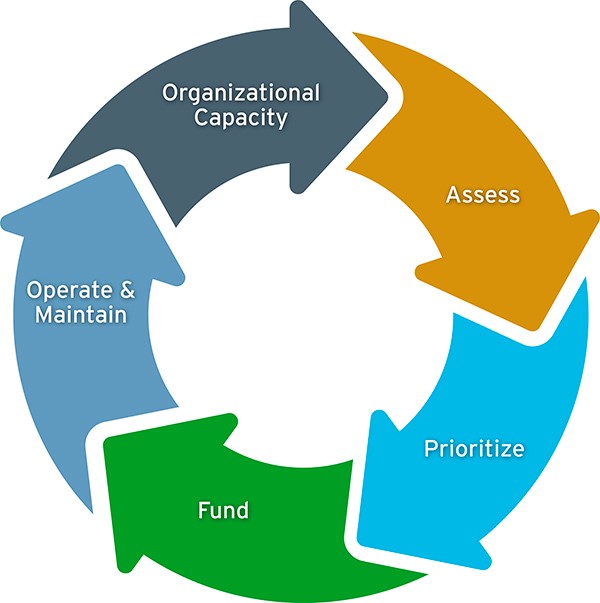
Preparing public transportation systems to weather the storm
A framework to navigate an iterative and ongoing climate resiliency process
By Andrew Brennan | National Practice Consultant | HNTB
Public transportation agencies are increasingly taking on the challenging task of making their systems more resilient in the face of extreme climate events. Much of the challenge lies in knowing where to start and what to prepare for. Because climate impacts differ throughout the United States, different regions will need to address resiliency differently.
Although massive capital improvement programs can be game changers for providing resilient infrastructure, most transit agencies rarely get the opportunity or the funding to take on such programs. More often, resiliency is achieved in small, progressive steps, such as improving storm drainage maintenance in flood-prone areas or introducing resilient evaluation and selection criteria during alternative analyses. In fact, normalizing these adaptations and others into day-to-day activities is a cost-effective best practice that can help avoid major capital projects in the future.
A framework for success
Instead of a program with a finite end, climate resilience is a cyclical, ongoing and iterative process. Below is a summary of the steps in the process as well as industry best practices.

1. Organizational Capacity
To internalize the practice of resiliency, owners may want to consider creating a climate-resiliency team led by a climate-resiliency champion responsible for weaving policies and best practices into organizational culture and ensuring the agency is in a better position to adapt as change occurs.
2. Assess
Vulnerability assessments help owners develop programmatic strategies to internalize and standardize the practice of climate resilience. By incorporating the latest science and state-of-the-art technologies such as geospatial analyses and LiDAR mapping, planning assessments can:
- Be conducted on any scale: statewide, regional, corridor or asset specific
- Identify specific climate stressors that threaten a transportation system
- Highlight assets at the highest risk for damage in the near, medium and long-term
- Place assets precisely within a given geography — even providing their elevation relative to the ground surface, which is critical in assessing flood risks
Readily available as well as customized software tools allow an agency to use climate and asset data effectively and efficiently to plan and manage transit and rail systems. The information can then facilitate strategic systemwide resiliency plans and inform capital investment strategies and operating and maintenance programs.
In Boston, the Massachusetts Bay Transportation Authority is utilizing the findings of its systemwide vulnerability assessment to prioritize climate-resilient design solutions as part of the Mattapan and Orange Lines Transformation Programs.
In the San Francisco Bay area, Bay Area Rapid Transit is one of many agencies facing significant impacts from climate change and sea level rise. HNTB collaborated with BART to assess the impact of climate change at key locations and developed a climate vulnerability assessment and resiliency plan to address benefit-cost analysis, constructability, operational factors and opportunities for implementation. Adaptation solutions were developed through a combination of stakeholder engagement and transit system technical analysis. HNTB also provided the agency with public-facing documents to support policy development and community education, as well as technical documentation to support engineering design considerations.
3. Prioritize
The scale at which climate resilience must occur far exceeds the capacity of any one owner to address all at once. The immense task often provokes the question, “Where do we start?” The best approach is prioritization based on critical factors, such as public safety, operational impacts, community support or lack thereof and the inevitable cost of not making the investment. Aligning an agency’s resilience and equity strategies may help bring the project hierarchy into sharper view.
4. Fund
Balancing the system’s needs against available funding is yet another challenging exercise. The good news is multiple federal grant opportunities could allow owners to begin tackling their project lists much sooner than anticipated:
- The Federal Emergency Management Agency funds natural hazard preparedness and resilience through its five-year, nearly $4 billion Building Resilient Infrastructure and Communities Program.
- The Infrastructure Investment and Jobs Act’s Promoting Resilient Operations for Transformative, Efficient, and Cost-Saving Transportation program allocates $7.3 billion in discretionary and formula funds through 2026 for planning studies, capacity-building and construction projects that make transit systems more resilient.
- The U.S. Department of Transportation and all the modal agencies identify climate as a key policy objective in all of their discretionary grant programs, including Capital Investment Grants, the Rebuilding American Infrastructure with Sustainability and Equity (RAISE) program, the Nationally Significant Multimodal Freight and Highway Projects program, and the National Infrastructure Project Assistance program. Infrastructure projects that directly address long-term climate impacts are naturally more compelling because they demonstrate to the U.S. DOT that agencies are making wise investments with federal funds.
5. Operate and Maintain
Changes to asset management systems based on findings from vulnerability assessments and criticality analyses are important ongoing steps to building a climate-resilient transportation system. They can include updating design guidelines and standards, material selections, operations and maintenance practices, emergency preparedness plans and engineering means and methods.
Progress, not completion
Transit systems may never be immune to the impacts of climate change. Still, owners can make a difference through agency-wide efforts and continual improvements using smart planning and data-driven decision-making. By embracing an internal culture of resiliency, leveraging new technologies, and working steadily to make incremental improvements, agencies can better position their systems to weather the storm and continue serving their communities.
ABOUT THE AUTHOR
 Andrew Brennan
Andrew Brennan
National Practice Consultant
HNTB
Andrew has nearly 30 years of experience in the transit industry. His primary focus has been the intersection of transit, sustainability and resiliency, specifically how to help transit agencies reduce their environmental footprints and make a transit network more resilient to the impacts of climate change.
Contact him at (617) 532-2223 or [email protected]
